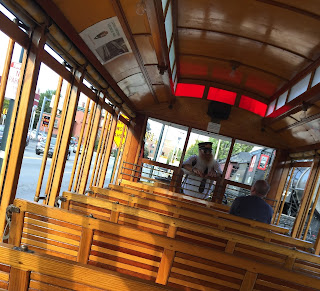More to see in Lowell (2 of 2)
From the Quilt Museum we hopped on to the trolley to visit the Boott Cotton Mills Museum, a National Historic Park in Lowell.
An added benefit of my "history of quilting" summer reading has been a better understanding of the evolution of textiles in the US. So, it was really cool to see where much of textile history was made. You enter this factory-turned-museum and step back in time.
From the Quilt Museum we hopped on to the trolley to visit the Boott Cotton Mills Museum, a National Historic Park in Lowell.
An added benefit of my "history of quilting" summer reading has been a better understanding of the evolution of textiles in the US. So, it was really cool to see where much of textile history was made. You enter this factory-turned-museum and step back in time.
Boott Cotton Mill was put into production in the mid-1830's. Young women composed the majority of the mill's workforce in Lowell. Given the machinery they were dealing with during very long days, their clothing, and even their hair styles, could be a liability in their work. This was a time when severe work injuries were common, when workers' rights and a fair living wage were a distant dream.
Imagine the noise level when all these machines are at full function...now imagine exposure to this environment for up to 14 hours a day!
Spools of thread, a loom, and yardage of finished fabric
Until the Industrial Revolution, the first step in producing a quilt, or any fabric item, was weaving the fabric. From the seamstresses' point of view, the mass production of fabric freed them of an entire step in the process and provided affordable, new options. But, when reviewing wills and inventories of estates, it can be seen that this also had the effect of devaluing the status of quilts in the home. In Northern Comfort, New England's Early Quilts 1780-1850, (page 38), authors Lynne Bassett & Jack Larkin write: "By the second quarter of the nineteenth century, textiles were no longer the expensive, prestigious items they had been in previous centuries; calico bed quilts had become affordable for the great majority of households." More quilts for more people, who can argue against that? One wonders though ... did the consumers of cheaper goods consider the costs for those who produced the fabric?
It turns out the mill operators rather liked their profits. They were resistant to changes in the work place and disinclined to reinvest those profits to keep their business current. The mills eventually closed in the mid-20th century.
It seems the more things change, the more they stay the same. On so many levels, we're still struggling to learn the lessons of the Lowell textile mills.
It turns out the mill operators rather liked their profits. They were resistant to changes in the work place and disinclined to reinvest those profits to keep their business current. The mills eventually closed in the mid-20th century.
It seems the more things change, the more they stay the same. On so many levels, we're still struggling to learn the lessons of the Lowell textile mills.







.jpg)
Comments
Post a Comment